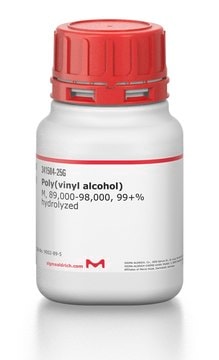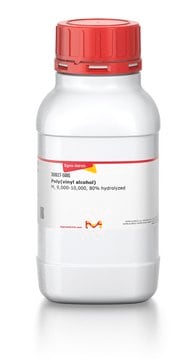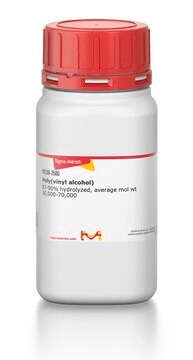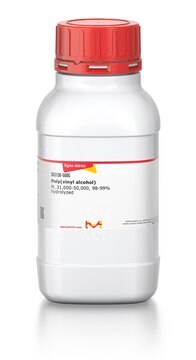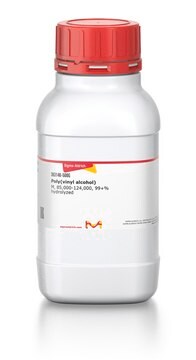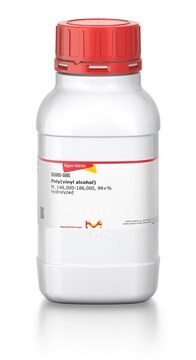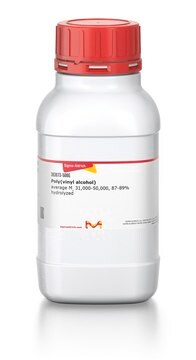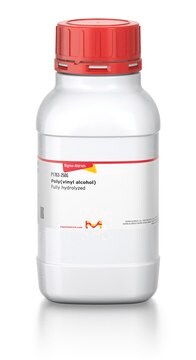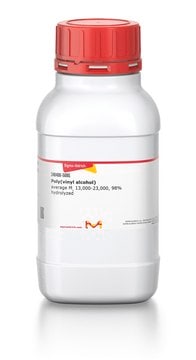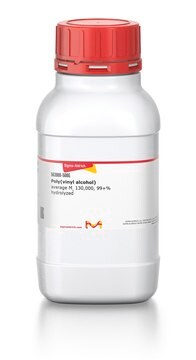If this product has an expiration or retest date, it will be shown on the Certificate of Analysis (COA, CofA). If there is no retest or expiration date listed on the product's COA, we do not have suitable stability data to determine a shelf life. For these products, the only date on the COA will be the release date; a retest, expiration, or use-by-date will not be displayed.
For all products, we recommend handling per defined conditions as printed in our product literature and website product descriptions. We recommend that products should be routinely inspected by customers to ensure they perform as expected.
For products without retest or expiration dates, our standard warranty of 1 year from the date of shipment is applicable.
For more information, please refer to the Product Dating Information document: https://www.sigmaaldrich.com/deepweb/assets/sigmaaldrich/marketing/global/documents/449/386/product-dating-information-mk.pdf
363170
Poli(vinil alcohol)
Mw 13,000-23,000, 87-89% hydrolyzed
Sinónimos:
PVA
Seleccione un Tamaño
Seleccione un Tamaño
About This Item
Productos recomendados
Quality Level
form
crystalline powder
crystals or granules
powder
mol wt
Mw 13,000-23,000
falling ball
3.5-4.5 cP, 4 % in H2O(20 °C)(lit.)
InChI
1S/C2H4O/c1-2-3/h2-3H,1H2
InChI key
IMROMDMJAWUWLK-UHFFFAOYSA-N
¿Está buscando productos similares? Visita Guía de comparación de productos
General description
Application
It can be used to prepare a hydrogel template to produce homogeneous microparticles for sustained drug release. PVA is used as a stabilizer in micro-particle preparation due to its high tensile strength and flexibility.
Features and Benefits
- Good mechanical and chemical stability
- Non-toxic
- Tunable hydrophilicity
- Resistance to solvents Capable of forming films
Storage Class
11 - Combustible Solids
wgk_germany
WGK 1
flash_point_f
No data available
flash_point_c
No data available
ppe
Eyeshields, Gloves, type N95 (US)
Elija entre una de las versiones más recientes:
¿Ya tiene este producto?
Encuentre la documentación para los productos que ha comprado recientemente en la Biblioteca de documentos.
Los clientes también vieron
-
How can I determine the shelf life / expiration / retest date of this product?
1 answer-
Helpful?
-
-
How is shipping temperature determined? And how is it related to the product storage temperature?
1 answer-
Products may be shipped at a different temperature than the recommended long-term storage temperature. If the product quality is sensitive to short-term exposure to conditions other than the recommended long-term storage, it will be shipped on wet or dry-ice. If the product quality is NOT affected by short-term exposure to conditions other than the recommended long-term storage, it will be shipped at ambient temperature. As shipping routes are configured for minimum transit times, shipping at ambient temperature helps control shipping costs for our customers. For more information, please refer to the Storage and Transport Conditions document: https://www.sigmaaldrich.com/deepweb/assets/sigmaaldrich/marketing/global/documents/316/622/storage-transport-conditions-mk.pdf
Helpful?
-
-
Do you have any data indicating an expected range of particle size for PVA, Poly(vinyl alcohol), products 363170 and 363138 (CAS 9002-89-5)?
1 answer-
The particle size is an internal specification, and there are no external specifications beyond the internal “S” grade. Internally, the focus is on ensuring there are no excessive quantities of fines (<100 Mesh) or excessive large particles (>14 Mesh). These internal requirements do not vary between the two products listed.
Helpful?
-
Active Filters
Nuestro equipo de científicos tiene experiencia en todas las áreas de investigación: Ciencias de la vida, Ciencia de los materiales, Síntesis química, Cromatografía, Analítica y muchas otras.
Póngase en contacto con el Servicio técnico